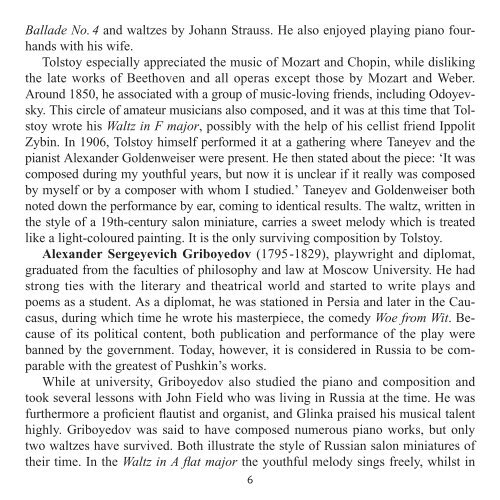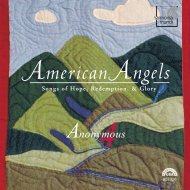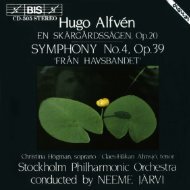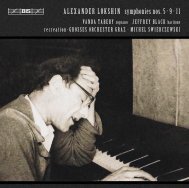Untitled - eClassical
Untitled - eClassical
Untitled - eClassical
You also want an ePaper? Increase the reach of your titles
YUMPU automatically turns print PDFs into web optimized ePapers that Google loves.
Ballade No. 4 and waltzes by Johann Strauss. He also enjoyed playing piano fourhands<br />
with his wife.<br />
Tolstoy especially appreciated the music of Mozart and Chopin, while disliking<br />
the late works of Beethoven and all operas except those by Mozart and Weber.<br />
Around 1850, he associated with a group of music-loving friends, including Odoyevsky.<br />
This circle of amateur musicians also composed, and it was at this time that Tolstoy<br />
wrote his Waltz in F major, possibly with the help of his cellist friend Ippolit<br />
Zybin. In 1906, Tolstoy himself performed it at a gathering where Taneyev and the<br />
pianist Alexander Goldenweiser were present. He then stated about the piece: ‘It was<br />
composed during my youthful years, but now it is unclear if it really was composed<br />
by myself or by a composer with whom I studied.’ Taneyev and Goldenweiser both<br />
noted down the performance by ear, coming to identical results. The waltz, written in<br />
the style of a 19th-century salon miniature, carries a sweet melody which is treated<br />
like a light-coloured painting. It is the only surviving composition by Tolstoy.<br />
Alexander Sergeyevich Griboyedov (1795-1829), playwright and diplomat,<br />
graduated from the faculties of philosophy and law at Moscow University. He had<br />
strong ties with the literary and theatrical world and started to write plays and<br />
poems as a student. As a diplomat, he was stationed in Persia and later in the Caucasus,<br />
during which time he wrote his masterpiece, the comedy Woe from Wit. Because<br />
of its political content, both publication and performance of the play were<br />
banned by the government. Today, however, it is considered in Russia to be comparable<br />
with the greatest of Pushkin’s works.<br />
While at university, Griboyedov also studied the piano and composition and<br />
took several lessons with John Field who was living in Russia at the time. He was<br />
furthermore a proficient flautist and organist, and Glinka praised his musical talent<br />
highly. Griboyedov was said to have composed numerous piano works, but only<br />
two waltzes have survived. Both illustrate the style of Russian salon miniatures of<br />
their time. In the Waltz in A flat major the youthful melody sings freely, whilst in<br />
6

















